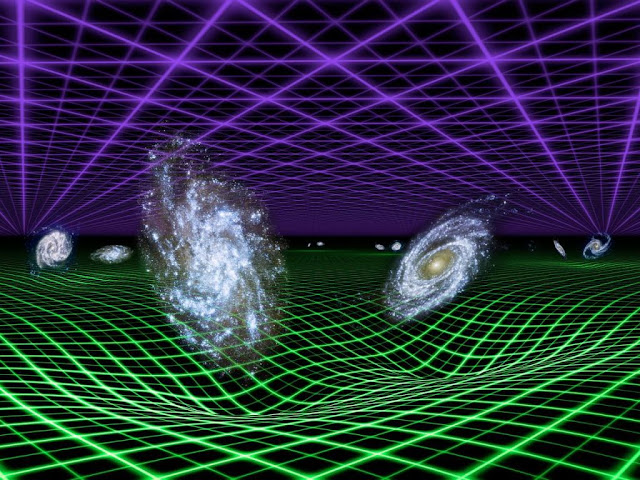Unifying quantum mechanics with general relativity is the ultimate dream — or nightmare — of physics. It would be a way to finally describe the force of gravity with the tools of quantum mechanics, unlocking how gravity works when it's really strong and at really small scales.
Einstein's theory of general relativity tells us that the warping of space and time is what we experience as the force of gravity. Quantum mechanics tells us that what we experience as the forces of nature really come in discrete, tiny chunks, known as quanta.

So, if gravity is the bending of space-time, gravity is a force and all forces are quantized, maybe space-time itself comes in discrete little blocks. Maybe there are fundamental units of space-time at some unfathomably tiny scale. Welcome to the theory of loop quantum gravity.
Fading into the background
One of the most annoying things that general relativity and quantum mechanics disagree about is the role that space-time plays in the physics. For quantum mechanics, space-time is just a background, a stage, a floor, a container for all the interesting interactions that make up the physics of the universe. Yes, that stage may bend and warp, and that bending and warping affect the paths of particles — but that's about it. All physics happens "on top" of that background space-time.
Even string theory — the purported "theory of everything" in which all particles and forces are just tiny bits of vibrating strings — assumes the existence of a background space-time to work off of. So that makes it a theory of … almost everything.
For general relativity, however, space-time isn't a background stage for the actors; it is the actor. General relativity doesn't assume a background; it creates it. General relativity is the language of the warping of space-time, and that very warping generates the physics of gravity.
So, in our quest to unite quantum mechanics with gravity, maybe we should take Einstein's theory at face value. If gravity simply is the mechanics of space-time, then to seek a quantum theory of gravity, we really need to seek a quantum theory of space-time. If we can crack that quantization, then by default, we'll end up with a quantum theory of gravity, and the problem will be solved.
Going for a loop
This is the approach known as loop quantum gravity. The word "loop" appears in the name because the theory's foundation is based on a rewriting of Einstein's general relativity in terms of lines (instead of points as it's usually done). It doesn't change any of the physics but makes some calculations easier, especially when it comes to quantizing space-time.
What does it mean to quantize space-time? It means there's a fundamental unit, a discrete chunk, of space-timey-ness that sits at some imperceptibly small scale. If you were to zoom in to this screen, the smooth curves and clean edges of the letters would be revealed as a vast number of little squares — pixels.
In much the same way, if you were to zoom in to space-time, you would see that time doesn't advance into the future continuously but in quick little tick-tick-ticks of a discrete clock. When you move, it wouldn't be a smooth motion; it would just consist of stuttering steps from one space-time pixel to another.
The biggest benefit of this quantization of space-time is that singularities simply go away. Singularities appear in Einstein's general relativity as places where densities go infinitely high and gravity becomes infinitely strong. We know that this really means that our understanding of the physics is going off the wall, and that we have no clue as to what's happening deep inside a black hole or at the beginning of the Big Bang, where singularities appear.
In loop quantum gravity, though, those singularities get replaced with really, really tiny chunks of ultradense (and, presumably, ultra-exotic) matter. We would simply banish those singularity demons from our universe and replace them with something understandable.
Not a perfect circle
What do those ultradense chunks of matter look like? Well, we're not sure. You see, loop quantum gravity isn't exactly complete. Although we've managed to develop some of the mathematics of "pixelated" space-time using a mathematical tool called spin networks, the biggest problem is that loop quantum gravity is a theory of strong gravity at small scales, which should automatically also be a theory of weak gravity at normal scales. That means that, if you use the mathematics of loop quantum gravity in non-crazy situations, like Earth orbiting the sun, you should get all the same results as you would from general relativity or old-fashioned Newtonian physics.
In other words, loop quantum gravity should contain within itself Einstein's general relativity, and we don't yet know if it does. You should be able to zoom out from the pixelated, quantum space-time view at the smallest scales and recover the smooth, undulating fabric of general relativity's space-time — and nobody knows how to do that.
There are other issues, too. Special relativity tells us that perceptions of time and space depend on our velocity but that our perception of fundamental physics should be the same. But different observers will have different views of the sizes of the quantized pixels of space-time, which will radically alter their views of physics. So that's a problem.
Loop quantum gravity is incomplete, and it may not work out. Just like its cousin string theory, which also claims to be a quantum theory of gravity, the mathematics of loop quantum gravity aren't revealing any workable solution. Some future scientist could crack the code, paving the way to a full understanding of the force gravity. Or, we could just be … wait for it … going in circles.
 Reviewed by Explore With Us
on
August 08, 2022
Rating:
Reviewed by Explore With Us
on
August 08, 2022
Rating:




No comments: